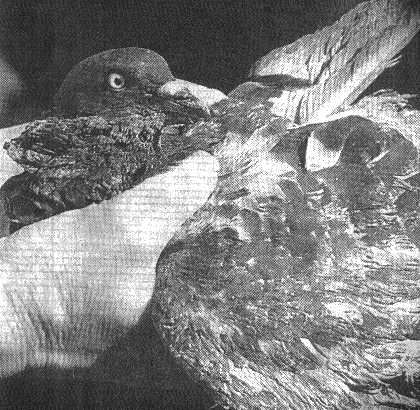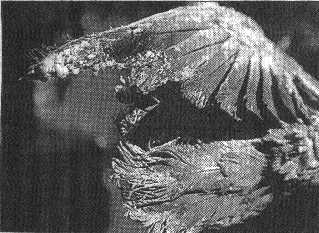|
Click on one of the underscored titles below to go to that home page:
VETERINARY
> |

Sticky situation"Safe" bird repellant creates horror storyBy Edythe Jensen
Apache Junction Paula Roth said the sight of dead and dying birds -- their feet, wings and beaks stuck to strips of gunk on her roof -- is a horror she will never forget. Roth said she feels terrible about requesting the application of "safe" bird repellant from a local pest-control company, and she hopes other consumers will hesitate before using similar products She said she was able to rescue only one of the wild birds caught in the sticky stuff before she called the pest-control company that applied it and demanded that it be removed "I was told that this was going to be a humane way of repelling birds. I had my house on the market and didn't want droppings all over," Roth said from her home in the Gold Canyon Ranch community east of Apache Junction "But when I saw the birds stuck there, and saw one put his beak in it, gasp a few times and die. I was crying, I was nearly hysterical." Roth said an employee from Aardvark Pest Control, the company that applied the repellant, spent most of the afternoon removing it from Roth's house.
Jeff Kimmick, owner of the pest-control company said it is unusual for birds to stick to the product as they did on Roth's roof "It may have been because temperatures were cold that day," he said. "It rarely causes more than brief discomfort for the birds. Kimmick said the product his company uses is "For the Birds" and is designed to repel birds from popular nesting spots by sticking to their feet making the area uncomfortable for them. However, Ellen Von Long, a bird rescue volunteer, who has state wildlife permits to nurse rescued birds in her Phoenix home, said the sticky substance kills more birds than it repels. She said the substance is so sticky that it can't be removed with non-toxic substances and stays on the birds' feet and feathers for about six months or until the bird molts and grows new feathers. Von Long is nursing the pigeon that Roth rescued from her roof. The bird is so covered with the gunk that Von Long must powder it frequently with cornstarch to ease the stickiness and must keep it in a cage until it grows a new set of feathers. She said when birds' feathers are stuck together with the repellant, they are unable to fly or to control their body temperature. Kimmick said he has always been sensitive to wildlife and uses the sticky repellent while other companies use poison. He said many Arizona home designs invite birds to nest -- two story homes with eaves, two-tiered tile roofs with plenty of nesting space, window ledges and roof mounted coolers attract birds searching for a nesting spot. Kimmick said his company tries to screen an area to keep birds away and uses the sticky product only in areas where screening won't work. He said he believes that most bird controlling substances on the market are poisons that can wind up killing predators, such as falcons, hawks, owls and domestic cats. "By the time people call our company to do something about birds around their home, they are asking us if it's legal to shoot them," Kimmick said, adding that he believes the birds are a public health hazard. Craig Levy, epidemiologist for the Arizona Department of Health Services said wild birds do not pose a health hazard. Indoor caged birds can spread a respiratory disease when droppings accumulate, dry out and mix with household dust. He said there has never been a case of psittacosis -- the respiratory disease found in bird droppings -- linked to wild bird species in Arizona. Von Long said there is a misconception that pigeons transmit diseases to humans. "I think people just don't like the droppings and feathers around," she said. *** |

